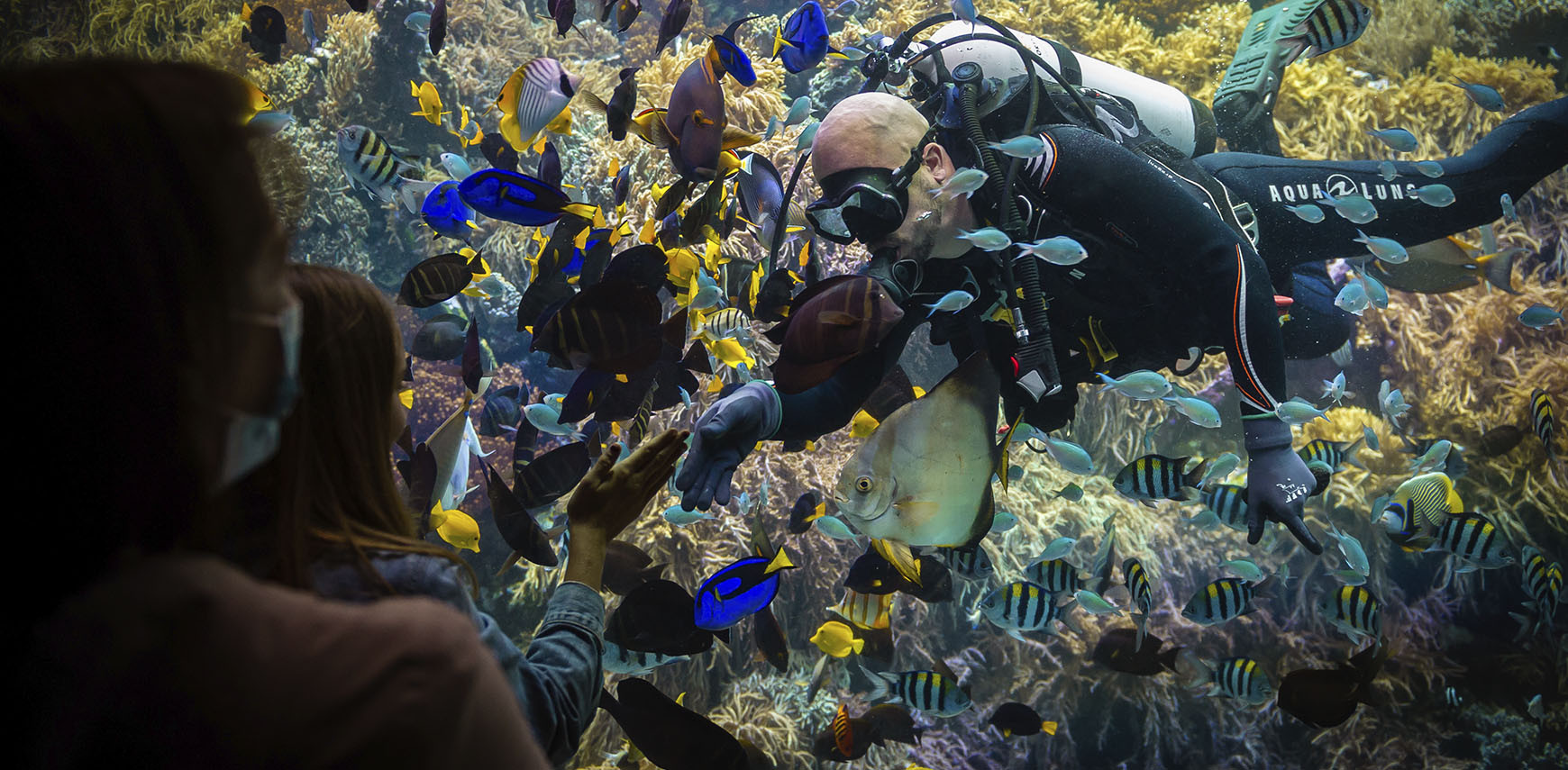Moral Warriors or Coral Warriors? Divers fight for fragile coral
The divers of Antwerp ZOO’s reef aquarium help the ZOO's artificial coral reef maintain its precarious balance. Just as in nature, this fragile ecosystem contains algae, fish, corals and other invertebrates, micro-organisms and so on, all of which are strongly affected by factors such as light intensity and the quality of the water. Various parameters, such as temperature, pH level, salinity, phosphate level and water currents are monitored continuously here. Also, the zookeepers responsible for the reef adopt a self-sustaining approach, in which they maintain the coral colony through cultivation. They create more coral by propagating fragments of soft, slow and fast-growing corals. After all, harvesting from nature is a big NO GO here! The divers educate ZOO visitors on this important topic, raise awareness of threats to natural reefs and advise on responsible diving etiquette in the wild. The moral of this story? Care for our coral!
The Great Barrier Reef has been receiving a lot of media attention recently. It is the largest coral reef in the world, and is currently experiencing the worst bleaching ever measured. The reef is vulnerable and is suffering the effects of climate change. Coral reefs are very sensitive to changes in temperature. When seawater becomes too warm, this causes bleaching: as corals become stressed, they expel the colourful algae living in their tissues. Consequently, as they cannot survive without these algae and the nutrients they provide, they corals start to die off. Due to climate change, this process has been speeding up in recent years. Although it is still possible for corals to recover from bleaching, they are still faced by many threats apart from climate change. These include overfishing, shipping traffic and pollution caused by industry and agriculture. (SOURCE: vrt NWS)
A bustling metropolis teeming with life
A coral reef is a gigantic ecosystem teeming with plants, fish, sea life and micro-organisms, all living in symbiosis with each other. It is a busy community containing as many as a hundred thousand different species. Although coral reefs occupy barely 0.2% of the Earth’s surface, they are home to 25% of the biodiversity of all marine life.Every link in the chain is needed to maintain the bustling metropolis’s delicate balance. To illustrate: fish such as surgeonfishes eat the algae that would otherwise suffocate the coral. Other species such as the ever-popular clownfish also live here and use the reef as a nursery, as a shelter, and as a source of food. Predator fish come here to hunt for smaller denizens. In short, reefs are highly delicate tangles of give-and-take, amazing wonders of nature.
Flower animals
Corals are actually animals, not plants. Larger colonies can be composed of hundreds of thousands of polyps. They are classified as Anthozoa, or ‘flower animals’, along with sea anemones. The coral polyps live in symbiosis with zooxanthellae, tiny algae that reside within their tissues. They are interdependent: the polyps can’t grow without the algae, while the algae can’t survive without the polyps. Did you know these tiny, single-celled algae are what gives coral its colour?
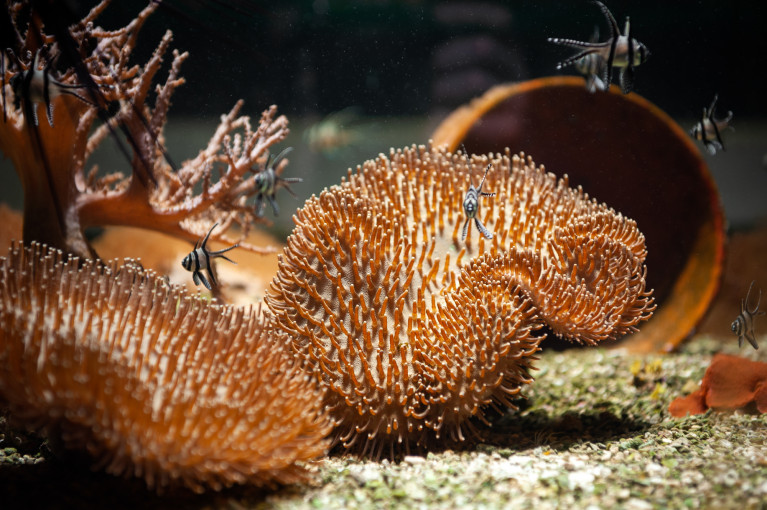
Photosynthesis
Light is very important, as it makes photosynthesis possible for the microscopically small algae. They use this to convert carbon dioxide (CO2) into oxygen-rich energy for the coral polyps. In turn, the polyps’ waste is transformed into nutritious substances for the algae. Furthermore, the colonies of coral polyps protect the tiny algae. As the coral is transparent, sunlight can still make its way through to the algae. It is immediately obvious why coral reefs need to be located where they are: in shallow, clear water, where the light easily filters through. This also explains why coral grows upwards. It is reaching for the light!
Hard and soft
There are several different types of coral. Hard, stony corals have skeletons made of calcium carbonate (limestone), which is used to build up a reef’s supporting structure. The polyps extract the calcium from seawater and deposit it beneath themselves. When they die, all that remains is this exoskeleton. This is subsequently used to support new coral polyps. Soft corals, on the other hand, attach themselves to rocks and other hard substrates. These corals move along with the ocean’s currents, are soft to the touch (never touch coral!) and can have the loveliest colours and shapes. Gorgonian and elkhorn corals exhibit elaborate branching structures, while leather corals have a wide, sturdy base. Genetic diversity is important underwater too! The coral reef at Antwerp ZOO consists of soft corals, with 15 different corals on display including Sinularia, Anthelia, Cladiella, Sarcophyton and Klyxum.
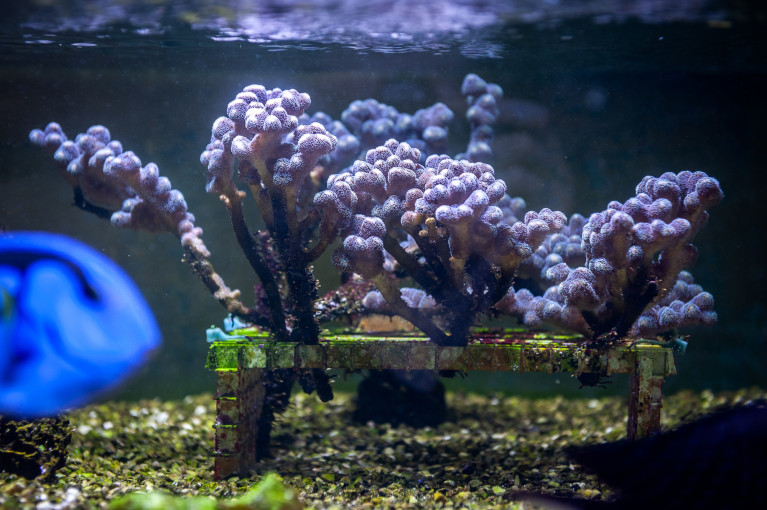
Reproductive cloud
In nature, reproduction is vital to ensure species survival and preserve a reef’s existence. Corals have evolved different reproductive strategies for survival. Some corals reproduce sexually, which is known as ‘coral spawning’. When night-time conditions are favourable, certain species of coral release millions of eggs and sperm into the ocean, all at the same time. This enormous ‘reproductive cloud’ is a very attractive source of food, and the eggs and sperm often end up in a fish’s belly before they ever get a chance to come together. If everything goes well, however, mass spawning such as this results in many, many fertilisations. After this, the embryos of all the various corals develop into planulae. These are larvae that are only a millimetre in length. They are then borne along by the seawater for several days to even months, already carrying zooxanthellae with them. Ultimately, the survivors anchor themselves to a handy rock, start forming their exoskeletons and become coral polyps. Other corals fertilise their eggs internally, and once the larvae have metamorphosed into tiny one-millimetre polyps, they are ready to start growing on the ocean floor immediately. However, they need to grow very quickly to avoid being covered in algae or buried in the sand. From then on, they can also reproduce asexually like other species of coral. To reproduce asexually, they create clones of themselves which then combine to form a new colony. Alternatively, they can reproduce through fragmentation. In this process, a piece of coral is broken off by a storm or an animal and the resulting fragments attach themselves to a suitable substrate and develop into new colonies.
At a snail’s pace
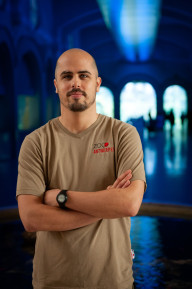
A reef’s core is built up out of dead material from old polyps. Young coral branches form on the exterior. Diver and zookeeper Thomas Van Puymbroeck is passionate on the subject: 'Corals grow at a snail’s pace. Some species grow only five millimetres in a year, while others may grow as fast as three centimetres a month.'
Coral cultivation
Down in the Aquarium’s basement, new corals are being grown in a special cultivation lab. Here, aquarium keepers propagate soft coral by cutting small fragments from a parent coral. They carefully remove any dead bits and algae from the fragments to keep these from overgrowing the colony. Then they use coral glue to attach them to plastic slides. In shallow water with illumination that mimics a tropical day/night cycle, the fragments become new coral colonies, growing no faster than three centimetres per month. Those are actually the speediest ones; most species of coral can only manage a few millimetres per month. Although corals are living animals, they do not feel pain like we do. Thomas continues: 'The fact that we cultivate our own coral means we are self-sustaining. Just as any other animals, we never take corals from their natural habitat. We do, however, trade species of coral with other members of EAZA (European Association of Zoos and Aquaria) that maintain artificial reefs.'
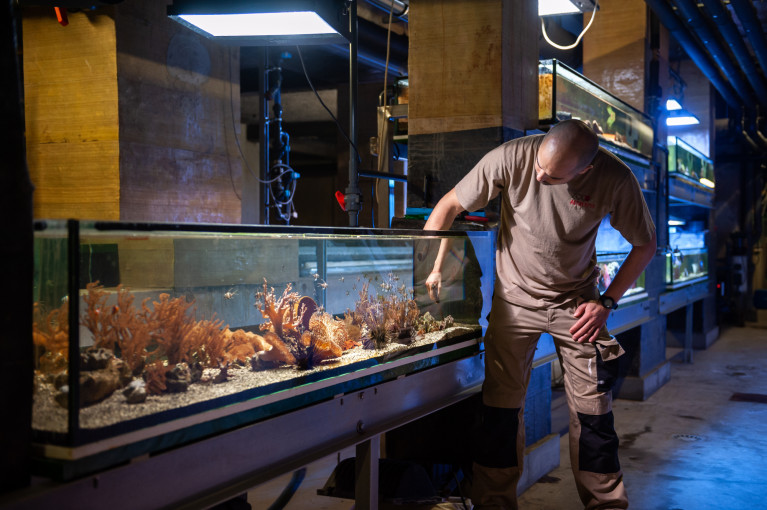
“The fact that we cultivate our own coral makes Antwerp ZOO self-sustaining in this respect. Just as any other animals, we never take corals from their natural habitat. We do, however, trade species of coral with other members of EAZA (European Association of Zoos and Aquaria) that maintain artificial reefs.” - Diver and zookeeper Thomas Van Puymbroeck
Own ecosystem
The coral reef at Antwerp ZOO’s Aquarium is one of the three largest reef aquariums in Europe that contains living corals. As in nature, the coral’s survival is dependent on such factors as light, temperature and the quality of the water. The aquarium is twelve metres wide and four metres high. New, energy-efficient LED lighting provides sufficient illumination for all the corals to thrive down to a depth of four metres. The lighting is on from 10 in the morning to 10 at night, mimicking a natural cycle. Behind a pane of acrylic 13 centimetres thick, 300,000 litres of 25°C North Sea water have been home to 1500 reef fish ever since 2015. The reef features as many as 50 different species, including blue-spotted stingrays, surgeonfish, damselfish, copperband butterflyfish, wrasses, parrotfish and various soft corals. The water quality’s delicate balance is affected by many different factors, including the temperature, acidity, and salinity of the water, as well as the movement of currents within the aquarium. That is why the Aquarium basement houses a very impressive technical system.
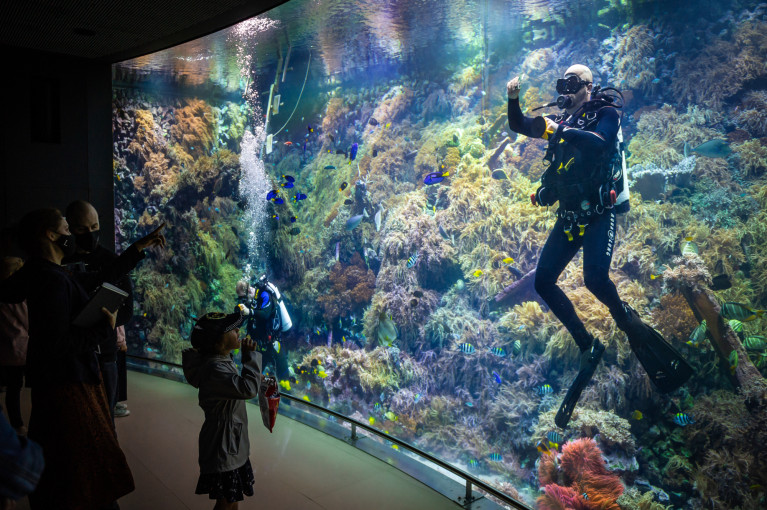
Besides being ichthyologists (experts on fish) and skilled divers, the Aquarium keepers also act as chemists and technicians. 'Maintaining a good water quality is a constant challenge. We use an ultra-modern water treatment system to help achieve that balance,' relates curator and marine biologist Philippe Jouk. This system includes a protein frother, for example, which uses foam to remove proteins and other organic substances and improve the water’s oxygen levels. A sand filter catches suspended particles and the biofilter’s bacteria break down any remaining organic waste. An osmosis machine turns tap water into nice clean water to replenish what is lost to evaporation. An ozone generator helps the frother to work more efficiently and ultraviolet lamps keep down the growth of bacteria, single-cell algae and viruses.
“Maintaining a good water quality is a constant challenge." - curator and marine biologist Philippe Jouk
Then one day, the balance failed. The previously dominant finger leather coral, or Sinularia flexibilis, started dying off. It became necrotic at the base and detached from the rocks. The coral polyps were immediately put under quarantine and a quest for effective treatment was launched. Meanwhile, the fish’s predation became too much for the corals still present in the tank to handle, and the nutrient balance was upset. The feeding schedule was adapted and the largest predators were moved elsewhere temporarily. The water parameters are now being tweaked to restore the reef’s balance. The reef fish are also being fed a special diet so they won’t be so hungry. Feeding rings with algae preparations are dangled in the water each day to keep the fish from gnawing away too much coral. The first corals have now been carefully re-introduced and appear to be doing well. Antwerp ZOO hopes to use the coral cultivated here to restore and expand the reef as soon as possible.
Doom scenario
Corals all over the world are in poor shape today. Over the last 30 years, 50% of the world's coral population has already died. If we don’t take action now, we will lose around 90% of all coral reefs by the end of this century. The influence of humanity on coral health is enormous. We need to take our responsibility in this desperately!
Global warming is causing ocean temperatures to rise. Coral reefs prefer water temperatures between 25°C and 29°C, depending on where they are located on the planet. If temperatures rise excessively, corals react by expelling zooxanthellae. As a result, they can no longer feed themselves, and they lose their colour and start to die off. Seawater absorbs greenhouse gases from the atmosphere and the water becomes more acidic due to the CO2. The resulting acidification stunts coral growth. The violent storms we have been experiencing more and more frequently are also causing damage to delicate coral reefs.
The majority of our planet’s human population lives along the coasts, which also has a detrimental effect on the reefs. The agricultural pesticides and waste we produce are harmful to coral, for example. Additionally, waste from sewers and agricultural fertiliser causes eutrophication, or overly nutrient-rich water, resulting in an overgrowth or ‘bloom’ of algae. Corals suffocate due to soil particles from land clearing and deforestation that end up in the water as well. Plastic soup is cluttering up the oceans.
Overfishing is disrupting these ecosystems. Normally, plant-eating fish graze the algae off the coral. However, due to overfishing, there are fewer fish consuming this algae. Consequently, the overabundance of algae is inhibiting the photosynthesis that is essential to coral growth. The result is a never-ending cycle: fewer fish, more algae, less photosynthesis, less coral. Destructive fishing methods using dynamite, dragnets and cyanide are causing even more damage to the coral.
“Coral reefs cannot keep up with the murderous pace of climate change. To turn the tide, we need to raise sufficient awareness for this problem. At the Aquarium, we do our best to do that each day during our 2 p.m. dive.” - Diver and zookeeper Thomas Van Puymbroeck
Tourism is another source of disruption and damage.Zookeeper Thomas, an avid diver, beseeches us: 'We can still turn the tide! Let us fight for coral health together. Swimmers, divers and snorkellers: please use coral-friendly sunscreen that isn’t harmful to micro-algae. Never touch a reef or stand on it when you become tired. Reefs are very fragile and parts of them can easy be broken off. Watch out where you drop anchor. And a special request to all tourists: never buy coral as a souvenir. Live coral is taken from the sea and sold illegally. It belongs in the ocean, not on your coffee table! Many corals grow only at a snail’s pace and are just as slow to adapt. Coral reefs cannot keep up with the murderous pace of climate change. To turn the tide, we need to raise sufficient awareness for coral reefs. At the Aquarium, we do our best to do that each day during our 2 p.m. dive.'

